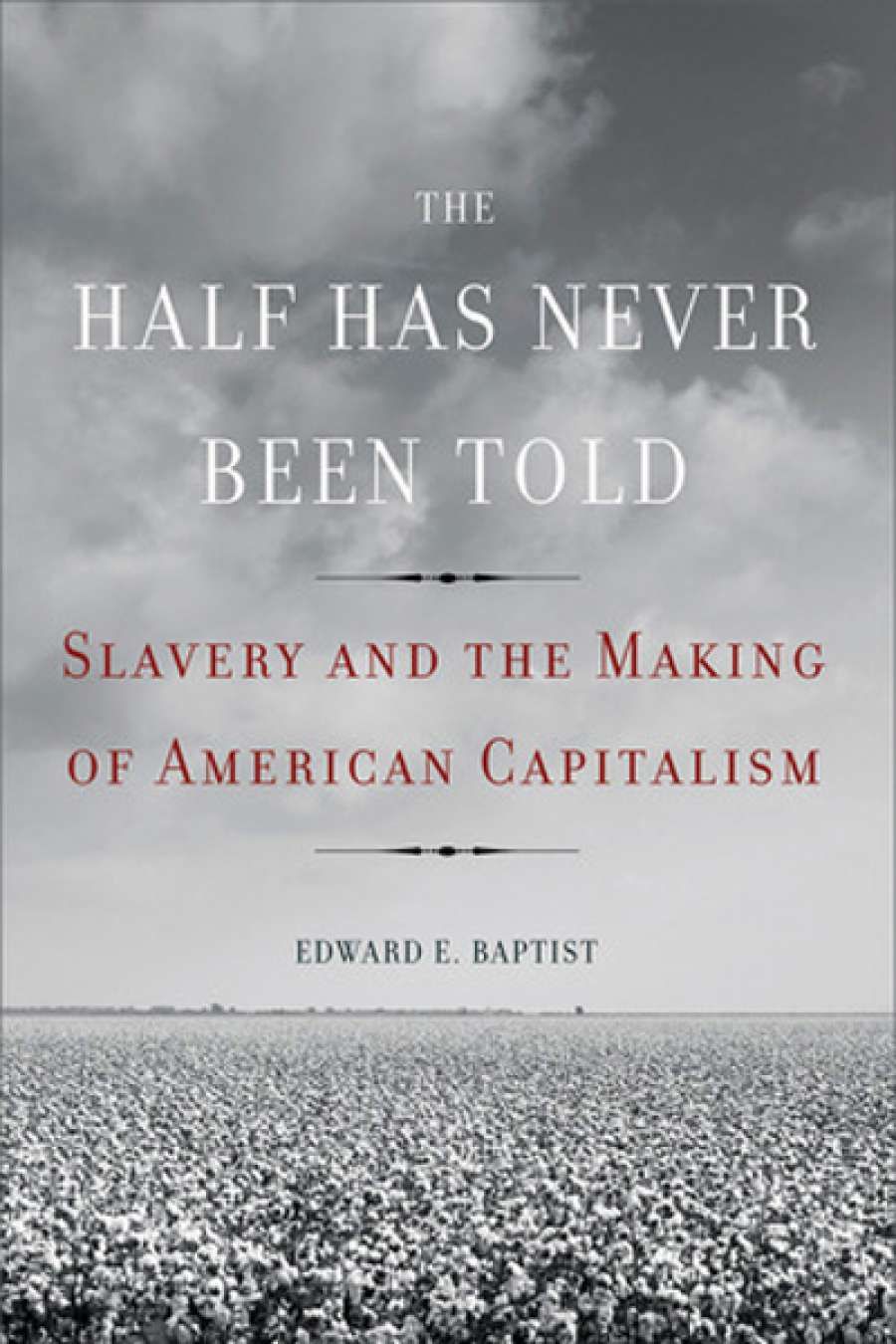
- Free Article: No
- Contents Category: United States
- Custom Article Title: Glenn Moore reviews 'The Half Has Never Been Told' by Edward E. Baptist
- Review Article: Yes
- Online Only: No
- Book 1 Title: The Half Has Never Been Told
- Book 1 Subtitle: Slavery and the making of American capitalism
- Book 1 Biblio: Basic Books (NewSouth), $44.99 hb, 525 pp, 9780465002962
The story involves a freed slave named Henry Clay (after the Whig senator) reminiscing about his life on a Louisiana plantation before the Civil War. One of his most vivid memories was of a 'big wooden wheel with a treadle on it, and when you tromp the treadle the big wheel go round. On that wheel was four or five leather straps with holes cut into them to make blisters, and you lay the negro down on his face on a bench and tie him to it.' When the master pedalled the machine, the straps thrashed the back of a man or woman tied to the bench until it bled.
Anyone who has studied the antebellum South would know how cotton growing – and, by extension, slavery – was made profitable by Eli Whitney's cotton gin, which allowed the cotton picked by the slaves to be processed quickly and efficiently. Similarly, demand for the processed cotton grew only after water-powered mills in New England towns like Lowell and Lawrence were able to produce cloth faster and cheaper than ever before. The New England mills are a proud part of America's industrial history and are celebrated in a wonderful museum in Lowell, but, the cotton gin aside, few associate slavery with technology. Instead, it is seen as an archaic and ultimately inefficient system, compared unfavourably with the industrial North.
The Half Has Never Been Told reminds us that the discipline imposed on Southern plantation slaves embodied the same industrial efficiency as a New England mill or a Pennsylvania iron works. Henry Clay, an old man when he was interviewed, remembered all too clearly how the mere threat of the whipping machine was enough to 'speed his hands'. The larger point Baptist makes here is that slavery was not the backward, dying institution that generations of historians portrayed. Indeed, it did not just borrow modern technology and business practices from the industrial North; according to Baptist, slavery, which he sees as an innovative, profitable institution, led the way, 'powering the modernization of the rest of the American economy'.
'He tells his American story through a series of smaller ones, each of which takes the reader back to antebellum America'
The implications here are grave. As Baptist notes: 'The idea that the commodification and suffering and forced labor of African Americans is what made the United States powerful and rich is not an idea that people are necessarily happy to hear.' Historians are not so bothered with the nation's guilty conscience or even possible restitution to the slave's descendants, but many have doubts about parts of Baptist's argument. In his New York Times review, Eric Foner asked why Virginia, which had more slaves than any other state, plays such a small part in the book. I suspect that Baptist would reply that Virginia was selling slaves to the cotton plantations in the Deep South where the real profits were being made, and that slavery's geographical centre was about to shift to coincide with its new economic hub.
 Edward E. Baptist (photograph by DeDe Hatch)
Edward E. Baptist (photograph by DeDe Hatch)
However, I am still not sure that slavery was as profitable as Baptist claims, or at least that it was profitable in the way that he suggests. Although cotton was enriching the American economy, the plantation owners themselves were sinking deeper into debt, with the real money being made by New England mill owners, the railroad and shipping magnates who transported the cotton North and across the Atlantic, bankers who lent money to the planters to sustain their lavish lifestyles, and the Northern manufacturers who sold the agrarian Southerners the things they couldn't make themselves. As the Southern secessionist James Debow complained, 'The slave owner dresses in Northern clothes, rides in a Northern saddle and reads Northern books.' For Southerners, this was economic imperialism. It hardly paints a picture of a profitable, dynamic, or even sustainable society, and, as the Civil War historian James McPherson has shown, by the 1850s 'three times as many people born in slave states migrated to free states than vice-versa'. People tend to vote with their feet on economic matters.
One must also ask, if slave-produced cotton was 'the rocket booster of American economic growth', how the economy kept powering ahead once it recovered from the destructive effects of the Civil War. (This question is germane because, as Baptist points out, cotton productivity dropped after the slaves were freed.) One answer is that other industries overtook cotton in importance. The Gilded Age was the age of steel, and the richest man in the world was not a New England mill owner nor a Southern planter, but Andrew Carnegie, whose Homestead mills used the latest Bessemer process to cut costs and increase productivity. Meanwhile, competition between New England mills relentlessly drove down the profit margin on cotton, but by then it didn't matter.
In spite of these unanswered questions, Baptist succeeds in demonstrating that the slave South was closely integrated into the national economy, and even though the term 'slavery' connotes backwardness, Southerners used modern business methods and innovative technology to make their 'whipping machine' run smoothly. Somehow this measured calculation makes slavery seem even worse. No longer can rogue 'Simon Legree' owners be blamed for slavery's cruel excesses – cruelty was simply good business practice – and the idea that such a system helped shape modern America becomes even more disturbing.


Comments powered by CComment